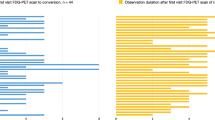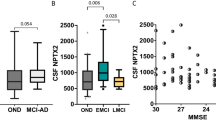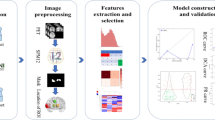Abstract
A high percentage of patients with mild cognitive impairment (MCI) develop clinical dementia of the Alzheimer type (AD) within 1 year. The aim of this longitudinal study was to identify characteristic patterns of cerebral metabolism at baseline in patients converting from MCI to AD, and to evaluate the changes in these patterns over time. Baseline and follow-up examinations after 1 year were performed in 22 MCI patients (12 males, 10 females, aged 69.8±5.8 years); these examinations included neuropsychological testing, structural cranial magnetic resonance imaging and fluorine-18 fluorodeoxyglucose positron emission tomography (PET) evaluation of relative cerebral glucose metabolic rate (rCMRglc). Individual PET scans were stereotactically normalised with NEUROSTAT software (Univ. of Michigan, Ann Arbor, USA). Subsequently, statistical comparison of PET data with an age-matched healthy control population and between patient subgroups was performed using SPM 99 (Wellcome Dept. of Neuroimaging Sciences, London, UK). After 1 year, eight patients (36%) had developed probable AD (referred to as MCIAD), whereas 12 (55%) were still classified as having stable MCI (referred to as MCIMCI). Compared with the healthy control group, a reduced rCMRglc in AD-typical regions, including the temporoparietal and posterior cingulate cortex, was detected at baseline in patients with MCIAD. Abnormalities in the posterior cingulate cortex reached significance even in comparison with the MCIMCI group. After 1 year, MCIAD patients demonstrated an additional bilateral reduction of rCMRglc in prefrontal areas, along with a further progression of the abnormalities in the parietal and posterior cingulate cortex. No such changes were observed in the MCIMCI group. In patients with MCI, characteristic cerebral metabolic differences can be delineated at the time of initial presentation, which helps to define prognostic subgroups. A newly emerging reduction of rCMRglc in prefrontal cortical areas is associated with the transition from MCI to AD.


Similar content being viewed by others
References
Kogure D, Matsuda H, Ohnishi T, et al. Longitudinal evaluation of early Alzheimer's disease using brain perfusion SPECT. J Nucl Med 2000; 41:1155–1162.
Petersen RC, Smith GE, Waring SC, Ivnik RJ, Tangalos EG, Kokmen E. Mild cognitive impairment. Clinical characterization and outcome. Arch Neurol 1999; 56:303–308.
Arnaiz E, Jelic V, Almkvist O, et al. Impaired cerebral glucose metabolism and cognitive functioning predict deterioration in mild cognitive impairment. Neuroreport 2001; 12:851–855.
Petersen RC. Mild cognitive impairment, and early Alzheimer's disease. The Neurologist 1995; 1:326–344.
Petersen RC, Smith GE, Waring SC, Ivnik RJ, Kokmen E, Tangelos EG. Aging, memory, and mild cognitive impairment. Int Psychogeriatr 1997; Suppl 1:665–669.
Roman GC, Tatemichi TK, Erkinjunti T, et al. Vascular dementia: diagnostic criteria for research studies. Report of the NINDS-AIREN International Workshop. Neurology 1993; 43:250–260.
Morris JC, Heyman A, Mohs RC, et al. The Consortium to Establish a Registry for Alzheimer's disease (CERAD). Part I. Clinical and neuropsychological assessment of Alzheimer's disease. Neurology 1989; 39:1159–1165.
Morris JC, Edland S, Clark C, et al. The Consortium to Establish a Registry for Alzheimer's disease (CERAD). Part IV. Rating of cognitive change in the longitudinal assessment of probable Alzheimer's disease. Neurology 1993; 43:2457–2465.
Welsh K, Butters N, Hughes J, Mohs R, Heyman A. Detection of abnormal memory decline in mild cases of Alzheimer's disease using CERAD neuropsychological measures. Arch Neurol 1991; 48:278–281.
Welsh KA, Butters N, Mohs RC, et al. The Consortium to Establish a Registry for Alzheimer's disease (CERAD). Part V. A normative study of the neuropsychological battery. Neurology 1994; 44:609–614.
Shulman KI, Shedletsky R, Silver IL. The challenge of time: clock-drawing and cognitive function in the elderly. Int J Geriatr Psychiatry 1993; 1:135–140.
Thalmann B, Monsch AU, Schreittner M, et al. The CERAD neuropsychological assessment battery (CERAD-NAB). A minimal data set as a common tool for German-speaking Europe. Neurobiol Aging 2000; 21:30.
Yesavage JA, Brink TL, Rose TL, et al. Development and validation of a geriatric depression screening scale: a preliminary report. J Psychiatr 1983; 17:37–49.
Gauggel S, Schmidt A. Was leistet die deutsche Version der Geriatrischen Depressionsskala (GDS)? Geriatrie Praxis 1995; 6:33–36.
McKhann G, Folstein M, Katzmann R, Price D, Stadlan EM. Clinical diagnosis of Alzheimer's disease: Report of the NINCDS-ADRA work group under the auspices of the Department of Health and Human Services Task Force on Alzheimer's Disease. Neurology 1984; 34:939–944.
Neary D, Snowden JS, Gustafson L, et al. Frontotemporal lobar degeneration. Neurology 1998; 51:1546–1554.
Minoshima S, Berger KL, Lee KS, Mintun MA. An automated method for rotational correction and centering of three-dimensional functional brain images. J Nucl Med 1992; 33:1579–1585.
Minoshima S, Koeppe RA, Frey KA, Kuhl DE. Anatomic standardization: linear scaling and nonlinear warping of functional brain images. J Nucl Med 1994; 35:1528–1537.
Bartenstein P, Minoshima S, Hirsch C, et al. Quantitative assessment of cerebral blood flow in patients with Alzheimer's disease by SPECT. J Nucl Med 1997; 38:1095–1101.
Minoshima S, Frey KA, Koeppe RA, Foster NL, Kuhl DE. A diagnostic approach in Alzheimer's disease using three-dimensional stereotactic surface projections of fluorine-18-FDG PET. J Nucl Med 1995; 36:1238–1248.
Drzezga A, Arnold S, Minoshima S, et al. F-18 FDG PET studies in patients with extratemporal and temporal epilepsy: evaluation of an observer-independent analysis. J Nucl Med 1999; 40:737–746.
Talairach J, Tournoux, P. Co-planar stereotaxic atlas of the human brain. New York: Thieme, 1988.
Ishii K, Willoch F, Minoshima S, et al. Statistical brain mapping of18F-FDG PET in Alzheimer's disease: validation of anatomic standardization for atrophied brains. J Nucl Med 2001; 42:548–557.
Signorini M, Paulesu E, Friston K, et al. Rapid assessment of regional cerebral metabolic abnormalities in single subjects with quantitative and nonquantitative [18F]FDG PET: a clinical validation of statistical parametric mapping. Neuroimage 1999; 9:63–80.
Small GW, Ercoli LM, Silverman DH, et al. Cerebral metabolic and cognitive decline in persons at genetic risk for Alzheimer's disease. Proc Natl Acad Sci U S A 2000; 23:6037–6042.
Minoshima S, Giordani B, Berent S, Frey KA, Foster NL, Kuhl DE. Metabolic reduction in the posterior cingulate cortex in very early Alzheimer's disease. Ann Neurol 1997; 42:85–94.
Small GW, Leiter F. Neuroimaging for diagnosis of dementia. J Clin Psychiatry 1998; 59 Suppl 11:4–7.
Ishii K. Clinical application of positron emission tomography for diagnosis of dementia. Ann Nucl Med 2002; 16:515–525.
Kordower JH, Chu Y, Stebbins GT, et al. Loss and atrophy of layer II entorhinal cortex neurons in elderly people with mild cognitive impairment. Ann Neurol 2001; 49:202–213.
Wolf H, Jelic V, Gertz HJ, Nordberg A, Julin P, Wahlund LO. A critical discussion of the role of neuroimaging in mild cognitive impairment. Acta Neurol Scand Suppl 2003; 179:52–76.
Salat DH, Kaye JA, Janowsky JS. Selective preservation and degeneration within the prefrontal cortex in aging and Alzheimer disease. Arch Neurol 2001; 58:1403–1408.
Brown DR, Hunter R, Wyper DJ, et al. Longitudinal changes in cognitive function and regional cerebral function in Alzheimer's disease: a SPECT blood flow study. J Psychiatr Res 1996; 30:109–126.
Mielke R, Heiss WD. Positron emission tomography for diagnosis of Alzheimer's disease and vascular dementia. J Neural Transm Suppl 1998; 53:237–250.
Fabrigoule C, Rouch I, Taberly A, et al. Cognitive process in preclinical phase of dementia. Brain 1998; 121:135–141.
Acknowledgements
We thank Brigitte Dzewas and Coletta Kruschke for their technical assistance and the radiochemistry group for their reliable supply of radiopharmaceuticals. We are obliged to Jodi Neverve for the very careful review of the manuscript.
Author information
Authors and Affiliations
Corresponding author
Rights and permissions
About this article
Cite this article
Drzezga, A., Lautenschlager, N., Siebner, H. et al. Cerebral metabolic changes accompanying conversion of mild cognitive impairment into Alzheimer's disease: a PET follow-up study. Eur J Nucl Med Mol Imaging 30, 1104–1113 (2003). https://doi.org/10.1007/s00259-003-1194-1
Received:
Accepted:
Published:
Issue Date:
DOI: https://doi.org/10.1007/s00259-003-1194-1




